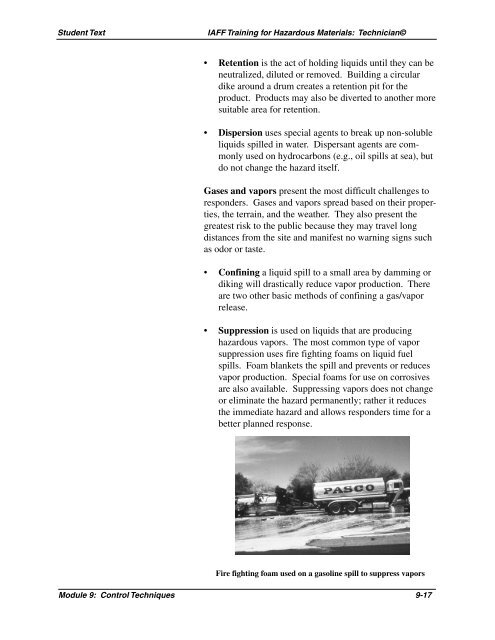Module 9: Control Techniques - International Association of Fire ...
Module 9: Control Techniques - International Association of Fire ...
Module 9: Control Techniques - International Association of Fire ...
Create successful ePaper yourself
Turn your PDF publications into a flip-book with our unique Google optimized e-Paper software.
Student Text IAFF Training for Hazardous Materials: Technician©<br />
• Retention is the act <strong>of</strong> holding liquids until they can be<br />
neutralized, diluted or removed. Building a circular<br />
dike around a drum creates a retention pit for the<br />
product. Products may also be diverted to another more<br />
suitable area for retention.<br />
• Dispersion uses special agents to break up non-soluble<br />
liquids spilled in water. Dispersant agents are commonly<br />
used on hydrocarbons (e.g., oil spills at sea), but<br />
do not change the hazard itself.<br />
Gases and vapors present the most difficult challenges to<br />
responders. Gases and vapors spread based on their properties,<br />
the terrain, and the weather. They also present the<br />
greatest risk to the public because they may travel long<br />
distances from the site and manifest no warning signs such<br />
as odor or taste.<br />
• Confining a liquid spill to a small area by damming or<br />
diking will drastically reduce vapor production. There<br />
are two other basic methods <strong>of</strong> confining a gas/vapor<br />
release.<br />
• Suppression is used on liquids that are producing<br />
hazardous vapors. The most common type <strong>of</strong> vapor<br />
suppression uses fire fighting foams on liquid fuel<br />
spills. Foam blankets the spill and prevents or reduces<br />
vapor production. Special foams for use on corrosives<br />
are also available. Suppressing vapors does not change<br />
or eliminate the hazard permanently; rather it reduces<br />
the immediate hazard and allows responders time for a<br />
better planned response.<br />
<strong>Fire</strong> fighting foam used on a gasoline spill to suppress vapors<br />
<strong>Module</strong> 9: <strong>Control</strong> <strong>Techniques</strong> 9-17
















